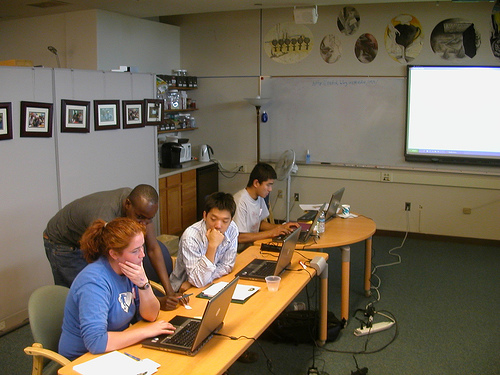Wiki Creation Tools For Schools
 WikiSpaces is a Wiki creation site offering a free service that schools can utilize as well as a subscription service for educational systems that wish to have no advertising, unlimited users, and other features. The WikiSpaces site has an effortless sign up process followed by an easy initiation into creating a wiki in the form of several different video tutorials available on the site.
WikiSpaces is a Wiki creation site offering a free service that schools can utilize as well as a subscription service for educational systems that wish to have no advertising, unlimited users, and other features. The WikiSpaces site has an effortless sign up process followed by an easy initiation into creating a wiki in the form of several different video tutorials available on the site.
The editing features on WikiSpaces will be immediately familiar to any school student or school teacher who has used Microsoft Word to type a document as all of the basic commands used to format a wiki page are exceedingly similar in both presentation and design. Linking one wiki page on WikiSpaces to another is extremely simple and allows for quick and easy grouping of content which would be handy in a classroom setting when multiple pieces of content may be interconnected within a lesson plan or learning unit.
![]() PBWorks is a similar platform that can have a school or classroom set up with a “secure online workspace”. Students can immediately begin creating and editing content while the site creator can set customized security settings and create an overall theme for the specific wiki.
PBWorks is a similar platform that can have a school or classroom set up with a “secure online workspace”. Students can immediately begin creating and editing content while the site creator can set customized security settings and create an overall theme for the specific wiki.
PBWorks keeps a complete list of all edits and creations on a particular wiki which allows teachers or administrators to ensure all relevant material remains on site. The audit trail also ensures that anyone who does remove necessary content or adds unnecessary data to the wiki page can be identified and have their actions corrected.
Both WikiSpaces.com and PBWorks.com could be utilized in the classroom as a “class hub” where important assignments can be presented. When a special assignment is handed out, the wiki can become a virtual meeting place for related information and a catalog of handy sources that students can easily reference and access online. Since Wikis are editable by anyone with access to the Wiki, students and teachers can continue to add relevant material as it is gathered and catalog it with new wiki entries and pages.
As education continues to progress and cross into new frontiers, the ability to collaborate virtually is going to become more and more important. Wikis offer a easy and effective way to collaborate and share knowledge in an educational environment.
Applications Of Wikis In The Classroom
There are few students with access to computers who have not utilized a Wiki in o ne form or another. Wikipedia.org’s editable encyclopedia has become a go to source for millions of people looking for quick and current information on a variety of topics while other Wiki applications such as Wetpaint and MediaWiki have opened up the doors for even more community input and creation within the Wiki universe.
ne form or another. Wikipedia.org’s editable encyclopedia has become a go to source for millions of people looking for quick and current information on a variety of topics while other Wiki applications such as Wetpaint and MediaWiki have opened up the doors for even more community input and creation within the Wiki universe.
When it comes to education, Wikipedia.org can be an invaluable tool for a student. While many teachers and schools do not accept Wikipedia as a valid source for school papers or reports due to its editable nature, many Wikipedia pages contain an extensive source or footnotes section of their own which contains links to the URLs where the initial reporting or information can be found. A student doing a research paper on the President or a movie star can use the Wikipedia page as a starting point to fan out to other resources that are easily attributed and 100% school approved.
Wiki technology can also be found at Wetpaint.com which is a website that allows anyone to create their own editable wikis around a topic. Wetpaint provides a domain and the tools needed to have the equivalent of a virtual bulletin board for a classroom. Since these wikis can be adjusted to a private setting that allows access by invitation only, they are a safe way for students to mingle and discuss class relevant topics when away from school.
Pictures and files can be uploaded to Wetpaint, and videos from YouTube can be embedded within a page, making the wikis created on Wetpaint.com perfect for classes that require a lot of visuals such as art, history, and science! The Wetpaint site is also a very good venue for classes with numerous examples of printouts or take home materials such as vocabulary lists or worksheets. These materials can be uploaded to the class site, and then accessed by the student from home.
For schools that have the required servers for operating MediaWiki, an even more advanced option for content creation exists. MediaWiki is a free software application that allows users to create a full Wiki that will greatly resemble Wikipedia.org and the MediaWiki site in terms of appearance and user driven editing. Secondary schools with more advanced computer courses could even consider a collaborative venture on a MediaWiki to be a group or class wide project during a term. A school with a rich history and several different departments may also wish to create a school specific Wiki.
As the demands of providing a well-rounded education increase, so will the capabilities and reach of Wikis. Considering the lack of cost involved in accessing these materials coupled with the benefits they provide to educators and students, Wiki technology can be a perfect fit for many classrooms.
7 School Tools For Making Your School More Digital
Students growing up in the digital ag e are likely to engage with digital technology in more and more aspects of their life. Part of the role of schools is to prepare students for the rapidly changing world which is quickly becoming more digital every day as new tools emerge to replace things that traditionally didn’t require the use of computers. Here are 7 tools that schools can use to become more digital.
e are likely to engage with digital technology in more and more aspects of their life. Part of the role of schools is to prepare students for the rapidly changing world which is quickly becoming more digital every day as new tools emerge to replace things that traditionally didn’t require the use of computers. Here are 7 tools that schools can use to become more digital.
1. Microblogging
Twitter, has become a popular new communication tool that can be really useful if used the right way. Many teachers, school administrators, and others share valuable information on Twitter via 140 character “Tweets”. One of the most important aspects of Twitter is its integration with SMS, so that users of Twitter can receive messages from people they follow on their cell phones, which almost all teachers, students, and parents carry with them. A principal of a school can send out important messages which can be received by all followers. Twitter also makes it easy to send direct messages to individuals that will be sent to their cell phone as well as their Twitter account that can viewed in a browser.
2. Online school calendars
Calendars are a tool that been used for thousands of years and an online version of the calendar can make calendars more useful. Online school calendars can be accessed from any computer with an internet browser and can be updated in real time when changes occur. This is a major upgrade from a paper based calendar that is usually in one location and can only be updated when a new calendar is printed out and sent out. An online calendar can also provide much greater detailed information, help organize and manage all the schools events, send information to external personal calendars, and many more things that paper calendars can not do.
3. Social networks
Social networks allow for effective communication between groups of individuals online. Facebook for instance allows the creation of groups where individuals can post information, have group discussions, or interact with each other. Yes, there are opportunities for wasting time, but these are outweighed by the benefits of the facilitation of collaboration and communication. Schools can even create their own social networks using tools like Ning.
4. Blogging
Blogging has democratized the publishing of content so that now anyone can write and publish content that will be read by as many people who are interested. Many teachers write blogs to discuss issues in education, share useful educational resources, or engage with students and parents. Students can improve their writing skills by creating their own blogs about topics that they care about. Some free tools that help easily create and publish blogs are Blogger, Edublogs, and WordPress.com.
5. Digital books
There are many advantages of switching to a digital format for books. A digital text book or book is much lighter to carry, which reduces the heavy weight many students carry on their backs. They can be updated more frequently and less expensively when information changes. Digital content also tends to be less expensive, as it reduces the publishers costs to distribute. Many classic books are available for free in digital format. One school has even replaced their entire library with a set of Kindles.
Digital books can be read on laptops, the iPod touch, netbooks, or eReaders like the Kindle or Nook. With the Kindle, students can get access to almost any book in about a minute as well as preview a vast library. The Nook allows a sharing feature so books can be shared between devices for a limited time for certain titles.
6. Wikis
Most people know about Wikipedia, the community driven encyclopedia, but Wikis also have tremendous potential as a collaboration tool. Sites like WetPaint allow you to create a free wiki for your school, a school project, etc. Users can add, edit, or view content to these wikis which can be great for collaboration and sharing information.
7. Online Video/ Podcasts
Students have unprecedented opportunity to broadcast their ideas and creativity by creating videos or audio recordings and publishing them for free on sites like YouTube or Podbean for audio. Students can produce shows, movies, or speeches that can be distributed to a worldwide audience. Some students created a rap video about math that has received over 3 million views. Using Ustream, teachers could broadcast a live recording of a lecture. There are also tons of free online lectures from top universities covering various subjects that are available at Academic Earth, YouTube, and iTunesU.
Can you think of additional tools to add to this list?
Photo by http://www.flickr.com/photos/zappowbang/ / CC BY 2.0